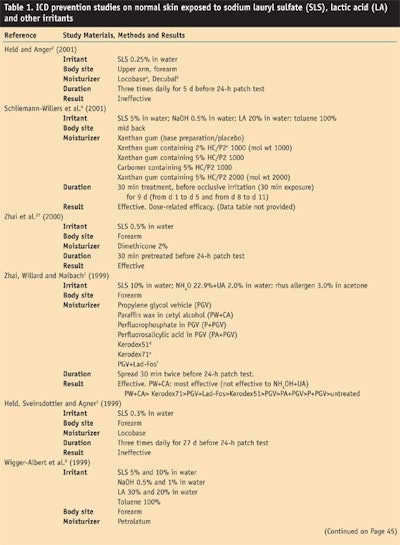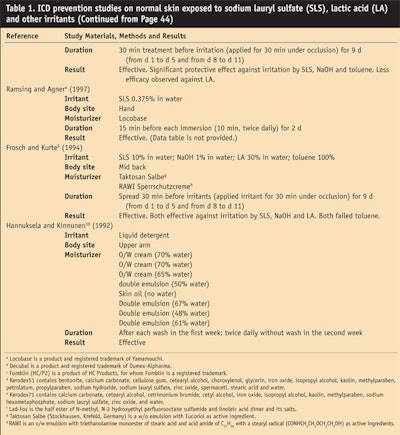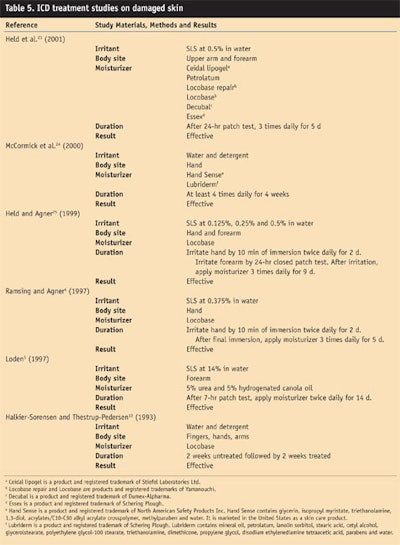*This article appeared on pages 65–72 in volume 55 of Contact Dermatitis in 2006 and appears here in a modified version with permission from Blackwell Publishing.
Moisturizers are used as prevention and treatment of surfactant and irritant dermatitis. Occlusives, humectants and hydrocolloids can be used to improve the function of the skin water barrier by increasing the moisture content.
Moisturizer efficacy remains unresolved. This evidence-based overview attempts to place the conflicting literature sources into a clinical and product development perspective.
Material and Methods
As an update to a previous overview by Zhai and Maibach,1 publications from 1992 to 2006 were reviewed quantitatively to examine moisturizer effectiveness. Pub Med from 1992 to 2006, Science Citation Index from 1992 to 2006, and Embasea from 1992 to 2006 were searched on these terms: moisturizer, irritant dermatitis, prevention and treatment.
Results on Prevention
Data on moisturizers’ efficacy in preventing irritant contact dermatitis (ICD) are presented in Table 1 (cont.), Table 2 and Table 3.
Preventing ICD in normal skin: Of the 10 studies performed on normal skin, those by Held and Agner2 and Held et al.3 suggest that using Locobaseb on normal skin caused increased susceptibility to experimental irritants. Ramsing and Agner4 had the opposite experience with this product. Direct comparison is problematic because different anatomical sites and exposure duration were used.
Held and Agner2 compared two moisturizers on normal skin. Nineteen healthy volunteers applied them three times daily for five days before 24-hr patch testing with sodium lauryl sulfate (SLS). Evaluation, including transepidermal water loss (TEWL), electrical capacitance, laser Doppler colorimetry and clinical scoring concluded that SLS skin response was increased on moisturizer-treated arms compared to controls for Locobase, while this was not statistically significant for the other moisturizer, Decubalc. This difference is most likely because of lipid content. Those authors suggest that increasing stratum corneum (SC) hydration enhances permeability to hydrophilic substances. A high level of SC hydration may facilitate transportation of a hydrophilic allergen, and this is likely to be positively related to lipid moisturizer content.5
Held et al.3 treated subjects three times daily with Locobase for 27 days before inducing irritation from a 24-hr SLS patch testing. They suggested that daily moisturizer use on normal skin may not necessarily offer protection against detergent irritation. Broader selections on irritants of differing physical-chemical properties are needed before generalizing these conclusions.
Schliemann-Willers et al.6 examined efficacy of perfluoropolyethers on 20 healthy volunteers. They observed differences in the protective efficacy against several irritants. They also observed a dose-related efficacy of perfluoropolyether phosphate.
Zhai et al.7 observed the effectiveness of skin-protective formulations in an in vivo human model previously described. Moisturizers were applied twice and allowed to dry each time for 30 min before 24-hr irritant patch testing of SLS, ammonium hydroxide plus urea, and rhus. Then they were assessed by clinical scoring. Paraffin wax in cetyl alcohol was the most effective formulation, but did not inhibit ammonium hydroxide and urea irritant dermatitis.
Wigger-Albert et al.8 evaluated the efficacy of protective creams on 20 healthy volunteers with assessments by visual scoring, TEWL and chromametry. In a two-week irritation assay, petrolatum was found to have significant protective effect against irritation by SLS, sodium hydroxide and toluene. Less efficacy was observed against lactic acid (LA).
Frosch and Kurte9 examined barrier cream efficacy and concluded that Taktosan Salbedsignificantly suppressed irritation by SLS, sodium hydroxide (NaOH) and lactic acid, which was apparent in most parameters. RAWI Sperrschutzcremeestrongly inhibited SLS irritation, but showed only a positive trend against NaOH and LA. Both creams failed against toluene.
These results suggest that the tested protective formulations provide some efficacy, but their applications remain chemical-specific.
Hanniksela and Kinnunen10 modeled an almost real work situation: regular use of emollients and detergents in a washing test. They concluded that regular use of emollients prevented irritant dermatitis from this detergent.
Prevention of ICD in damaged skin: Berndt et al.11 compared barrier cream with its vehicle. Fifty hospital nurses with mild signs of compromised skin on their hands were followed during one month in a field study. They applied cream frequently during work and especially before contact with skin irritants. SC hydration demonstrated no significant differences.
Halkier-Sorensen and Thestrup-Pedersen12 used Locobase for two weeks of treatment followed by two weeks untreated on 111 cleaners and kitchen workers in a field study measuring skin surface temperature, electrical capacitance and TEWL. Locobase was effective among cleaners and kitchen assistants during everyday exposure to water and detergents.
Prevention of ICD in normal and damaged skin: Kampf et al.13 studied emollients (0.81% w/w) used twice daily over two weeks on 35 subjects, half of whom had an atopic predisposition. The researchers concluded that the addition of emollients to a propanol-based hand rub can significantly decrease ICD under frequent-use conditions.
These are not pure prevention studies as they utilized moisturizers for prevention and treatment.
Discussion on Prevention
This overview is based on 12 efficacy publications from 1992 to 2006.
Data limitations include lack of formula quantitative composition, making direct comparisons problematic. Note that proprietary, registered trade names often remain constant due to brand identity, but the chemical formulation may change; hence comparison, by trade name, in the quoted publications does not document sameness. Thus, what is needed to ascertain efficacy are the principles of formulation chemistry in moisturizers. And for this purpose, there is a need for an experimental model moisturizer for comparative studies. The benchmark sunscreen used in SPF assays represents such an approach. The same can be said for validating relevancy of patch test occlusive models because these systems differ from typical open applications in industrial use.
Examination of some points might aid interpretation of future investigations.
•Skin reactivity varies, depending on anatomical site. The hand and forearm are commonly studied. The volar forearm was a more discriminating site than the dorsal hand.14 Marked regional variations in skin reactivity are attributed to differences in keratinization and in the density of epidermal shunts such as hair follicles and sweat ducts.15 Additional comparisons of anatomical site reactivity might aid generalization from the data at one site.
•When exposure inducing acute irritant dermatitis is repeated, the dermatitis tends to persist and becomes chronic. Dermatitis that lasts more than six weeks can be called chronic, according to one suggestion for an arbitrary threshold period. In chronic ICD, which is the most common type of ICD, the exposure period exceeds the skin recovery time.16 Chronic ICD may differ biologically from acute ICD. Therefore, it is necessary to examine the relation between the acute irritant experimental model and the chronic irritant experimental model.
•The physical-chemical properties of moisturizer ingredients must be more clearly defined in relationship to their role in moisturizer efficacy.
SLS, an anionic surfactant used as an emulsifier in many pharmaceutical vehicles, cosmetics, foaming dentifrices and foods,17 is a widely utilized irritation model.18 However, our model studies should be extended to a broader range of chemicals of varying characteristics.
Many studies use a 24-hr patch application. But in real life, surfactant exposure is usually of short duration, open application and cumulative. In recent years, assay methods resembling usage situations have been developed. Examples include repeated short duration chamber test, repeated open application test, plastic occlusion stress test (POST), and soak or wash tests.19 Validation based on actual work situation or home environment will, in the end, prove or disprove the relevance of these models. Much remains to be done; these model systems should accelerate the knowledge growth curve.
The authors of this article believe that moisturizers are sometimes effective for preventing and treating irritant dermatitis. However, moisturizer efficacy may not be broadly effective2,6 and may be relatively specific against certain acids, bases, hydrophilics and lipophilics.
Hyperhydration occurs in wet work and with prolonged wearing of gloves. Water and occlusion may irritate. Zhai and Maibach20 and Tsai and Maibach21 overviewed this complex biology. Much definitive experimental work on the effect of occlusion on irritants and allergens remains to be done.
New rapid-throughput percutaneous penetration models may aid moisturizer development and provide insights; Karande22 reports transdermal penetration enhancer mixtures that increase skin permeability to macromolecules (~1–10 kDa) by up to ~100-fold in vitro without inducing skin irritation. Should this model be appropriately validated, formulation development would be accelerated. When efficacy techniques are validated, product labeling based on a specific efficacy test, such as the SPF test, would aid the health care professional and the consumer. In this case, the term Moisturizing Protection Factor or MPF could be applied.
Results on Treatment
Data on moisturizers’ efficacy in treating ICD are presented in Table 4 and Table 5. These combined studies showed that some moisturizers decreased irritation and enhanced repair.
Held et al.23 examined moisturizers on SLS-irritated human skin, concluding that the most lipid-rich moisturizers improved barrier restoration more rapidly than less lipid-rich moisturizers.
McCormick et al.24 examined 54 health care workers with severe hand irritation (74% with one or more full-thickness cracks or other integumentary breaks) and examined chronic ICD in a field study. These authors concluded that an oil-containing lotion or a barrier cream can protect against drying and chemical irritation.
Held and Agner25 compared two test models (hand and volar forearm) in evaluating the effect of Locobase. Both models were useful; the moisturizer accelerated regeneration of the skin barrier function in both hands and volar forearms. The proposed forearm model seemed more sensitive than the more realistic but cumbersome hand immersion model.
An immersion test more faithfully mimics dishwashing liquids in a realistic exposure.26
Ramsing and Agner4 used an immersion test to examine the effect of a moisturizer; 12 volunteers were treated with Locobase thrice daily for five days after the final SLS immersion (day 3). These researchers concluded that the moisturizer could accelerate regeneration of the barrier function of irritant skin.
McCormick et al.24 and Halkier-Sorensen and Thestrup-Pedersen12 examined hospital nurses, health care workers, and cleaning and kitchen workers under actual work situations. Their treatment results demonstrated efficacy, but McCormick et al. compared an oil-containing lotion with a novel barrier cream and did not include a control group.24
Discussion on Treatment
Moisturizers as a class have many potential advantages in treatment. The challenge for workers in this field consists of building strong theoretical bases for understanding physicochemical aspects of the irritants and the moisturizers. That understanding can provide the user with optimal formulations directed for treatment against specific irritants.
Conclusion
Taken together, these recent quantitative data provide the basis for future investigations. Because of the ubiquitous nature of irritant contact dematitis, the extension of the work summarized here justifies priority. For an updated summary of other aspects of moisturizer science, see Loden and Maibach28 and Fluhr et al.29
References
1.H Zhai and H Maibach, Moisturizers in preventing irritant contact dermatitis: an overview, Contact Derm 38 241–244 (1998)
2.E Held and T Agner, Effect of moisturizers on skin susceptibility to irritants, Acta Derm Venereol 81 104–107(2001)
3.E Held, S Sveinsdottier and T Agner, Effect of long-term use of moisturizer on skin hydration, barrier function and susceptibility to irritants, Acta Derm Venereol 79 49–51 (1999)
4.D Ramsing and T Agner, Preventive and therapeutic effect of a moisturizer, Acta Derm Venereol 77 335–337 (1997)
5.M Loden, Barrier recovery and influence of irritant stimuli in skin treated with a moisturizing cream, Contact Derm 36 256–260 (1997)
6.S Schliemann-Willers, W Wigger-Albert and P Elsner, Efficacy of a new class of perfluoropolyethers in the prevention of irritant contact dermatitis, Acta Derm Venereol 81 392–394 (2001)
7.H Zhai, P Willard and H Maibach, Putative skin-protective formulations in preventing and/or inhibiting experimentally-produced irritant and allergic contact dermatitis, Contact Derm 41 190–192 (1999)
8.W Wigger-Albert et al, Experimentally induced chronic irritant contact dermatitis to evaluate the efficacy of protective cream in vivo, J Amer Acad Dermatol 40 590–596 (1999)
9.P Frosch and A Kurte, Efficacy of skin barrier creams, Contact Derm 31 161–168 (1994)
10.A Hanniksela and T Kinnunen, Moisturizers prevent irritant dermatitis, Acta Derm Venereol 72 42–44 (1992)
11.U Berndt et al, Efficacy of a barrier cream and its vehicle as protective measures against occupational irritant contact dermatitis, Contact Derm 42 77–80 (2000)
12.L Halkier-Sorensen and K Thestrup-Pedersen, The efficacy of a moisturizer (Locobase) among cleaners and kitchen assistants during everyday exposure to water and detergents, Contact Derm 29 266–271 (1993)
13.G Kampf et al, Emollients in a propanol-based hand rub can significantly decrease irritant contact dermatitis, Contact Derm 53 344–349 (2005)
14.V Charbonnier et al, An open assay model to induce subclinical non-erythematous irritation, Contact Derm 42 207–211 (2000)
15.S John and H Schwanitz, Functional skin testing: the SMART procedures, in Irritant Dermatitis, A Chew and H Maibach, eds, Berlin: Springer (2006) pp 211–221
16.A Chew and H Maibach, Ten genotypes of irritant contact dermatitis, in Irritant Dermatitis, A Chew and H Maibach, eds, Berlin: Springer (2006) pp 5–9
17.C Lee and H Maibach, The sodium lauryl sulfate model: an overview, Contact Derm 33 1–7 (1995)
18.I Effendy and H Maibach, Detergents, in Irritant Dermatitis, A Chew and H Maibach, eds, Berlin: Springer (2006) pp 249–256
19.C Lee and H Maibach, Sodium lauryl sulfate, in Irritant Dermatitis, A Chew and H Maibach, eds, Berlin: Springer (2006) pp 257–267
20.H Zhai and H Maibach, Skin occlusion and irritant and allergic contact dermatitis: an overview, Contact Derm 44 201–206 (2001)
21.TF Tsai and H Maibach, How irritant is water? An overview, Contact Derm 41 311–314 (1999)
22.P Karande, A Jain and S Mitragotri, Discovery of transdermal penetration enhancers by high-throughput screening, Nature Biotechnol 22 192–197 (2004)
23.E Held, H Lund and T Agner, Effect of different moisturizers on SLS-irritated human skin, Contact Derm 44 229–234 (2001)
24.R McCormick, T Buchman and D Maki, Double-blind, randomized trial of scheduled use of a novel barrier cream and an oil-containing lotion for protecting the hands of health care workers, Am J Infect Control 28 302–310 (2000)
25.E Held and T Agner, Comparison between 2 test models in evaluating the effect of a moisturizer on irritated human skin, Contact Derm 40 261–268 (1999)
26.F Simon, In vivo models of skin irritation, in Irritant Dermatitis, A Chew and H Maibach, eds, Berlin: Springer (2006) pp 489–499
27.H Zhai et al, A bioengineering study on the efficacy of a skin protectant lotion in preventing SLS-induced dermatitis, Skin Res Technol 6 77–80 (2000)
28.M Loden and H Maibach, Dry Skin and Moisturizers Chemistry and Function, 2nd edn, Boca Raton: Taylor & Francis (2006)
29.J Fluhr et al, Bioengineering of the Skin: Water and the Stratum Corneum, 2nd edn, Boca Raton: CRC Press (2005)
















